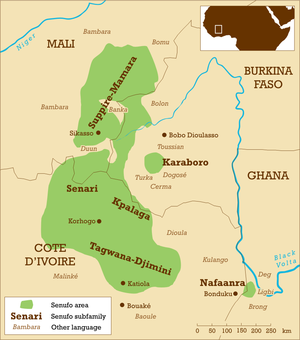
Summary
The Senufo or Senufic languages (Senoufo in French) has around 15 languages spoken by the Senufo in the north of Ivory Coast, the south of Mali and the southwest of Burkina Faso. An isolated language, Nafaanra, is also spoken in the west of Ghana. The Senufo languages constitute their own branch of the Atlantic–Congo sub-family of the Niger–Congo languages. Garber (1987) estimates the total number of Senufos at some 1.5 million; the Ethnologue, based on various population estimates, counts 2.7 million.[year needed] The Senufo languages are bounded to the west by Mande languages, to the south by Kwa languages, and to the north and east by Central Gur languages.
| Senufo | |
|---|---|
| Senoufo | |
| Geographic distribution | northern Ivory Coast, southern Mali, southwestern Burkina Faso, western Ghana |
| Linguistic classification | Niger–Congo?
|
| Subdivisions | |
| Glottolog | senu1239 |
 Map of the Senufo language area showing the major groups and some neighbouring languages. | |
The Senufo languages are like the Gur languages in that they have a suffixal noun class system and that verbs are marked for aspect. Most Gur languages to the north of Senufo have a two tone downstep system, but the tonal system of the Senufo languages is mostly analysed as a three level tone system (High, Mid, Low).
The Senufo languages have been influenced by the neighbouring Mande languages in numerous ways. Many words have been borrowed from the Mande languages Bambara and Jula. Carlson (1994:2) notes that ‘it is probable that several grammatical constructions are calques on the corresponding Bambara constructions’. Like Mande languages, the Senufo languages have a subject–object–verb (SOV) constituent order, rather than the subject–verb–object (SVO) order which is more common in Gur and in Niger–Congo as a whole.
Classification edit
Delafosse (1904:192–217) was the first linguist to write on the Senufo languages. He noted that the Senufo were often confused with the Mande, partly because use of Mande languages by the Senufo was widespread:
- [L]a langue mandé s'est répandue parmi eux, des alliances nombreuses ont eu lieu... C'est là l'origine de la confusion que l'on a faite souvent entre Mandé et Sénoufo ... alors que, au triple point de vue ethnographique, antropologique et linguistique, la différence est profonde entre ces deux familles. (p. 193)
In the influential classifications of Westermann (1927, 1970[1952]) and Bendor-Samuel (1971), the Senufo languages were classified as Gur languages. Starting with Manessy (1975) however, this classification was called into doubt. In 1989, John Naden, in his overview of the Gur family, stated that ‘[t]he remaining languages, especially Senufo, may well be no more closely related to Central Gur than to Guang or Togo Remnant, or than these to Central Gur or Volta-Comoe’ (1989:143).
Subclassification edit
Early Senufo classifications (e.g. Bendor-Samuel 1971) were mainly geographically motivated, dividing the Senufo languages into Northern, Central, and Southern Senufo. In subsequent years, this terminology was adopted by several linguists working on Senufo languages (Garber 1987; Carlson 1983, 1994). Mensah (1983) and Mills (1984) avoided this geographical terms but used mainly the same grouping, according to Garber 1987. SIL International in its Ethnologue subdivides the Senufo languages in six groups. Combining the two classifications results in the grouping below.
Northern Senufo
Central Senufo
- Karaboro languages
- Eastern Karaboro (Kar) (40,000 speakers)
- Western Karaboro (Syer-Tenyer) (30,000 speakers)
- Senari languages
- Cebaara (Tyebaala) (860,000 speakers)
- Senara (spoken in Côte d'Ivoire) (210,000 speakers)
- Nyarafolo (60,000 speakers)
- Kpalaga (Palaka) (spoken in Côte d'Ivoire) (8,000 speakers)
Southern Senufo
- Tagwana–Djimini languages
- Djimini (Dyimini) (spoken in Côte d'Ivoire) (96,000 speakers)
- Tagwana (Tagouna) (140,000 speakers)
- Nafaanra (Nafaara) (61,000 speakers)
Footnotes edit
References edit
Linguistic features edit
- Carlson, Robert (1994) A Grammar of Supyire. Berlin/New York: Mouton de Gruyter. ISBN 3-11-014057-8.
- Carlson, Robert (1997) The Senufo Languages. CP/CV 2: Actes du CILG1, 23–42.
- Garber, Anne (1980) 'Word order change and the Senufo languages.' In Studies in the Linguistic Sciences, 10, 1, 45–57.
- Garber, Anne (1987) A Tonal Analysis of Senufo: Sucite dialect (Gur; Burkina Faso). PhD dissertation, Urbana: University of Illinois / Ann Arbor: UMI.
- Garber, Anne (1991) 'The phonological structure of the Senufo word (Sicite)', Journal of West African Languages, 21, 2, 3–20.
- Manessy, Gabriel (1996a) 'La determination nominal en sénoufo', Linguistique Africaine, 16, 53–68.
- Manessy, Gabriel (1996b) 'Observations sur la classification nominale en sénoufo', Afrika und Übersee, 79, 21–35.
- Mills, Elizabeth (1984) Senoufo phonology, discourse to syllabe (a prosodic approach) SIL publications in linguistics (ISSN 1040-0850), 72.
Classification edit
- Bendor-Samuel, John (1971) 'Niger–Congo: Gur' in: Thomas Sebeok & Jack Berry (eds.), Linguistics in sub-saharan Africa (Current trends in linguistics 7), The Hauge/Paris: Mouton, 141–178.
- Delafosse, Maurice (1904) Vocabulaires comparatifs de plus de 60 langues ou dialects parlés à la Côte d' Ivoire ou dans les régions limitrophes (avec des notes linguistiques et ethnologiques, une bibliographie et une carte). Paris: Leroux.
- Manessy, Gabriel (1975) Les langues Oti–Volta. Paris: SELAF.
- Mensah, E.N.A. and Z. Tchagbale (1983) Atlas des langues Gur de Côte d’Ivoire. Abidjan: Institut de Linguistique Applique.
- Westermann, Diedrich & Bryan, M.A. (1970 [1952]). The Languages of West Africa. Oxford: International African Institute / Oxford University Press.
- Williamson, Kay & Blench, Roger (2000) 'Niger–Congo', in Heine, Bernd & Nurse, Derek (eds.) African languages: an introduction, Cambridge: Cambridge University Press, 11—42.


